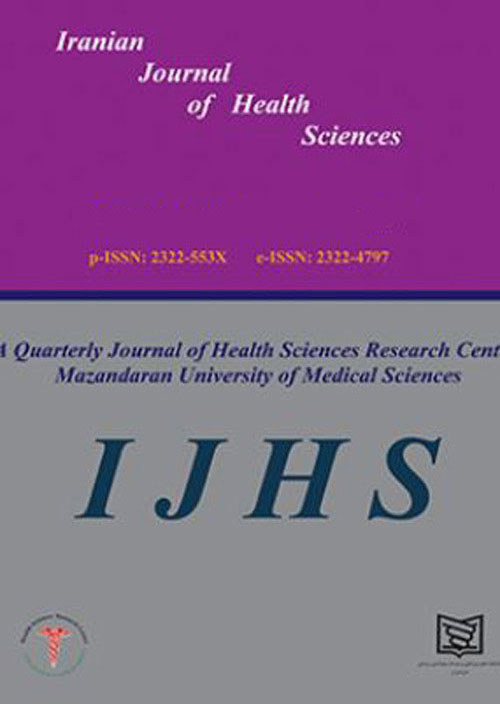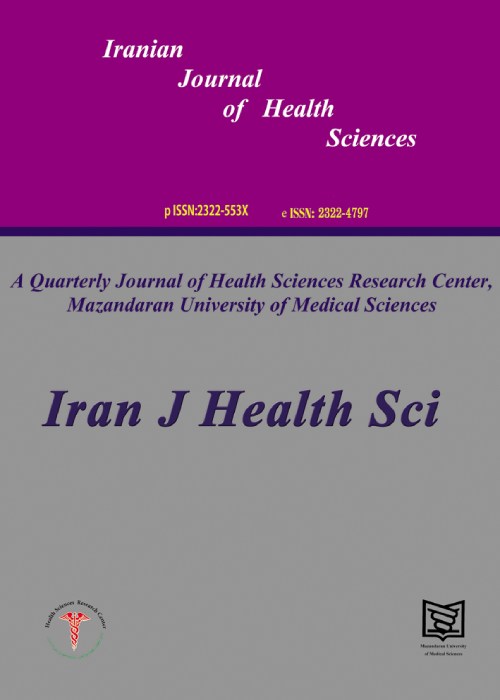فهرست مطالب

Iranian Journal of Health Sciences
Volume:9 Issue: 3, Summer 2021
- تاریخ انتشار: 1400/07/04
- تعداد عناوین: 5
-
-
Pages 1-11Background and Purpose
COVID-19 could be a threat to healthcare workerschr('39') mental health. This study was conducted to investigate job burnout and its relationship with the resilience level of the personnel in the COVID-19 treatment hospital in southern Iran.
MethodsThis descriptive-analytical cross-sectional study was conducted in 2021 on 496 personnel of Hazrat Ali Asghar (AS) Hospital selected as the center of COVID-19 in southern Iran. The participants of the study were selected using the census. Data collection tools were the standard Maslach Burnout Inventory (MBI) and Connor-Davidson Resilience Scale (CD-RISC). Data analysis was performed using t-test, ANOVA, Pearson correlation coefficient, and multiple linear regression in SPSS23 at a significance level of 0.05.
ResultsThe mean scores of job burnout and resilience were 76.95 ± 14.36 (of 132) and 71.21 ± 8.24 (of 125), respectively which indicated the moderate level of these two variables. There was a significant inverse correlation between job burnout and resilience (P<0.001, r= - 0.514). Spiritual influences (P<0.001), perception of competence (P=0.001), positive acceptance of change and secure relationships (P= 0.001), trust in individual instincts (P= 0.02), and control (P= 0.03) of resilience aspects were identified as predictors of job burnout. Additionally, there was a statistically significant relationship between job burnout and gender (P=0.001) and occupational group (P= 0.04); and between resilience and gender (P= 0.02) and with marital status (P= 0.03).
ConclusionJob burnout status and personnel resilience were at a moderate level. It was recommended to train employees with resilience-enhancing skills employees according to each of their dimensions.
Keywords: Job burnout, Resilience, Pandemic, Coronavirus, COVID-19 -
Pages 12-22Background and purpose
There is concern that students may have an unhealthy lifestyle as a result of changes that occurred during corona conditions, so this study aimed to determine the status of the lifestyle and its relationship with the demographic characteristics of postgraduate students during the corona span.
Material and MethodsThis cross-sectional study was conducted at Tehran University of Medical Sciences in 2020. The link to the online Health-Promoting Lifestyle Questionnaire Profile2 was sent to conduct the research. To examine the relationships between the mean scores of health-promoting lifestyle and different variables, an independent samples t-test was applied in the case of dichotomous demographic variables (gender, education level, and income-generating activity), while one-way analysis of variance test was used to evaluate the multilevel demographic variables (marital status, place of residence, and faculty). The Pearson correlation coefficient was also used for testing age.
ResultsThe sample 240, (75.4%) were female and 145 of them, (60.4%) were single. The mean age of them was 32.21±7.45.45 years old. The lifestyle total score was 138.28± 21.18 at the average level. The highest score was related to spiritual growth (26.93±5.01), whereas the lowest score was reported on physical activity (16.92±5.17). The difference between the mean of health-promoting lifestyle was not significant in terms of demographic variables.According to the results, a statistically significant difference was observed between male and female students in the field of nutrition. Also, students were significantly different in the nutrition domain regarding students’ residence (p-value <0.05). Spiritual growth was significantly different among students in terms of marital status (p-value <0.05).
ConclusionAlthough the mean score of health-promoting lifestyle was not different from other studies, further studies are proposed to plan health interventions in accordance with epidemic conditions for students.
Keywords: COVID-19, Demography, Health Promotion, Student, Life Style -
Pages 23-34Background and Purpose
The electronic referral system was established in Iran with the aim of increasing access to care, improving interaction, and efficient use of resources. The purpose of this study was to determine the effective factors in the establishment and implementation of electronic referral system in Iran
MethodsThe present study was qualitative with a content analysis approach. In order to collect information, in-depth and semi-structured interviews were used. After interviewing 42 people, the information was saturated. The interviews were transcribed and analyzed, and the main topics were quoted, cited, and coded. The content analysis method was used and all authors participated in the analysis process to avoid bias and agreement.
Results: Four main themes and eleven sub-themes were mentioned as effective themes in the implementation of the electronic referral system by the interviewees including resource management (human resource management, financing and equipment, and infrastructure), stewardship (policy-making, inter-sectorial leadership, and intra-sectorial governance), advocacy stakeholders (senior officials and policy-makers related to the program, service providers, community), and social commitment (commitment and accountability of service providers).
ConclusionsSuccessful implementation of electronic referral systems requires the development of an operational plan that correctly identifies the factors affecting the establishment and implementation, as well as the cooperation of all responsible organizations which can help improve the establishment and sustainability of the program. It is suggested that managers and officials active in the field of health services use the results of this study in the establishment and implementation of electronic referral system.
Keywords: Referral, Consultation, Tertiary Care Centers, Hospitals, Hospital Information Systems -
Pages 35-48Background and Purpose
Social marketing (SM) is a fitting strategy in world health that is aimed to ensure attitude correction in the community, laying the foundation for the behavioral changes resulting in health promotion in the community. The purpose of this research was to explain the role of social marketing in promoting community health.
MethodsThis was applied research conducted through a descriptive survey. For data gathering, a mixed quantitative/qualitative approach was adopted. The statistical population included the youth under 25 years old who smoked cigarettes in Mazandaran Province. Based on the Cochran formula, a sample consisting of 385 respondents was formed, and the individual members of it were selected using proportionate random sampling. The data on social marketing mix and normative system were collected using the questionnaires constructed by Pang and Kubacki [1] and Issock et al. [2], respectively. The data on advertisement were collected using the questionnaire constructed by Dunn and Nisbett [3]. Data analysis was performed in PLS Software using Structural Equation Modeling.
ResultThe result indicated that the messenger’s features influenced the user perception of social marketing and had a positive effect on the user normative system. Further, the results suggested that the user normative system affected their perception of social marketing.
ConclusionIt was concluded that marketing practitioners can manipulate consumer perception of social marketing by shaping ethical norms.
Keywords: Social Marketing Mix, Community Health Improvement, Behavior Change -
Pages 49-60Background
The process of obtaining oral health information, evaluating its concepts and using appropriate prevention and treatment processes in the field of Oral health literacy (OHL) is within the scope of health literacy and is the link between culture and society, health system, education system, and oral health consequences. The purpose of the current study was to investigate OHL in first-grade high school students in Babol.
Materials and MethodsThe present study was a cross-sectional study on 383 high school students in Babol 2019 using the multi-stage cluster sampling method in the first stage of school selection and in the second stage of class selection. The data were collected using demographic, oral health behaviors assessment, and Oral Health Literacy Questionnaire. OHL questionnaire has 17 questions in four sections of reading comprehension, numeracy, listening, and decision making. Regression analysis, ANOVA, T-test, and chi-square test were used for data analysis (SPSS 23).
FindingsThe mean score of studentschr('39') OHL was 8.33 ± 2.004, and 11.7%, 26.1%, and 61.9% of the students were with adequate, borderline, and inadequate levels of OHL, respectively. According to the analysis, OHL had a significant relationship with income, father’s education, tooth brushing, and use of beverage foods.
ConclusionThe results showed that OHL was insufficient among students, and more efforts and interventions were required to improve oral health and increase oral health literacy among student
Keywords: Adolescents, Oral Health Literacy, Behavior, Oral Health


